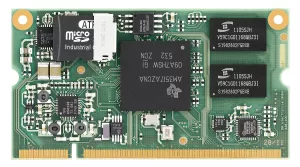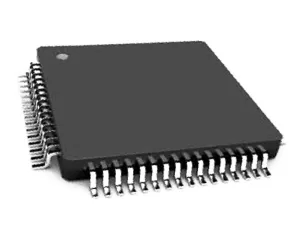
Exploring Main Differences between Embedded Systems and Microcontrollers
September 04 2023 
Inquiry
Global electronic component supplier AMPHEO PTY LTD: Rich inventory for one-stop shopping. Inquire easily, and receive fast, customized solutions and quotes.
QUICK RFQ
ADD TO RFQ LIST
In this blog post, we will discuss the main differences between embedded systems and microcontrollers. We will also provide some examples of applications of them.
What is an Embedded System?
An embedded system is a computer system with a specific purpose within a larger mechanical or electronic system. It consists of a computer processor, computer memory, and input/output peripherals. It is incorporated into a full gadget that frequently also contains mechanical and electrical components. An embedded system frequently has real-time computing limitations since it typically controls the physical operations of the machine it is embedded within. Many commonly used gadgets are controlled by embedded systems.
Video related to Embedded System
Embedded Systems Features
- Real-time operation: Embedded systems need to react instantly to outside events. They must therefore be able to process and react to data fast, frequently in just a few milliseconds or microseconds.
- Low power consumption: Embedded systems must be made to use as little power as possible because they frequently run on batteries or have constrained power sources.
- Reliability: Embedded systems must be designed to function dependably in all circumstances since they are frequently employed in safety-critical applications, such as medical devices and automotive systems.
- Small size: To make them simple to integrate into other systems, embedded systems are frequently made to be lightweight and compact.
What is a Microcontroller?
A microcontroller is an integrated circuit that has a CPU, memory, and input/output ports on a single chip. It is frequently utilized in embedded systems and is created to carry out a certain purpose. Microcontrollers are employed in a variety of tasks, including as regulating a room's temperature or a spacecraft's flight. Additionally, they are frequently found in household appliances like microwaves, washing machines, and televisions.
Microcontrollers Features
- The fact that these instructions are in macro-type is advantageous. It can be applied to replace multiple instructions at once.
- Microcontrollers with exceptionally low power consumption have been made possible by new technologies. They typically accommodate voltages between 1.8 and 5.5 V.
- Because they utilise cutting-edge memory, microcontrollers are exceedingly user-friendly and quite reliable. High-end ROM memories, which benefit from technology advancements like EEPROM, are superior and significantly more capable in storage capabilities. Also possible are further cycles of writing and erasing.
Key Differences between Embedded Systems and Microcontrollers
| Feature | Embedded System | Microcontroller |
| Size | Can be large or small | Typically small |
| Cost | Can be expensive or inexpensive | Typically inexpensive |
| Power consumption | Can be high or low | Typically low |
| Reliability | Can be less reliable or highly reliable | Typically highly reliable |
| Environment | Can operate in a variety of environments | Typically designed to operate in harsh environments |
| Applications | A wide variety of applications | A variety of applications, but typically used in small, inexpensive devices |
Applications of Embedded Systems and Microcontrollers
Applications of Embedded Systems
- Automobiles: In contemporary automobiles, embedded systems or numerous computers (up to 100 in some cases) are frequently used to carry out a variety of functions. Some of these systems carry out fundamental utility tasks, while others offer entertainment or user-facing features. Cruise control, backup sensors, suspension control, navigation systems, and airbag systems are a few embedded technologies found in consumer vehicles.
- Mobile phones: These devices contain a variety of embedded systems, such as operating systems (OSes), GUI software and hardware, cameras, microphones, and USB I/O (input/output) modules.
- Industrial equipment: These devices can both incorporate embedded systems, such as sensors, and act as embedded systems. Embedded automation systems that carry out particular monitoring and control tasks are frequently found in industrial machinery.
- Medical devices: These could include embedded systems, such as sensors and control systems. Medical devices, like commercial machines, must also be very user-friendly to avoid machine errors that may have been avoided. This implies that they frequently have a more complicated OS and GUI created for a suitable UI.
Applications of Microcontrollers
Wide variety of applications
- Automobiles: The engine, gearbox, and brakes are just a few of the many operations that microcontrollers are employed to handle in automobiles.
- Appliances: Microcontrollers are employed in appliances to control a number of features, such as the microwave oven's timer or the refrigerator's thermostat.
- Industrial equipment: Microcontrollers are used in industrial equipment to regulate a number of variables, such as the temperature of a furnace or the speed of a motor.
- Medical devices: A pacemaker or an insulin pump are just two examples of the many operations that microcontrollers may manage.
- Toys: A range of functions, including the movement of a robotic toy or the sound effects of a video game, are controlled by microcontrollers in toys.
- Home automation devices: Microcontrollers are utilized in home automation systems to manage a number of features, including the lighting, thermostat, and security system.
- Telecommunications devices: Microcontrollers are employed in telecommunications equipment to control a number of operations, including call switching and data encryption.
- Military systems: A number of tasks, including the control of drones and missile guidance, are carried out using microcontrollers in military systems.
Microcontroller for Cubesat
Small satellites called "CubeSats" are frequently employed for teaching and research. A microcontroller is often one of many standardized modules that make up this type of device. A CubeSat's microprocessor manages the tasks of the satellite, including attitude control, power management, and data transfer. The software for the satellite is also run by it. A CubeSat's size, power consumption, and processing power needs are only a few of the variables that affect the microcontroller that is best suited for the satellite. Popular CubeSat microcontrollers include:- The Arduino Uno: Open-source microcontroller boards like the Arduino Uno are popular for DIY and educational projects. It is a wonderful option for novices because it is user-friendly and reasonably affordable.
- The Raspberry Pi: Using the Raspberry Pi A credit-card-sized computer called the Raspberry Pi can be used as a microcontroller. It is a fantastic option for more complicated projects because it is more powerful than the Arduino Uno and has more functionality.
- The STM32F407: The STM32F407 is a common 32-bit microcontroller used in commercial and industrial applications. It is a fantastic choice for demanding applications because it is more capable and adaptable than the Arduino Uno or the Raspberry Pi.
Dual Core Microcontrollers
A microcontroller with two processing cores is called a dual core microcontroller. This boosts the system's performance by enabling the microcontroller to handle two jobs at once. Dual core microcontrollers are becoming more and more common in embedded systems as a result of their ability to boost the performance of systems that need to do multiple tasks at once. The Intel Atom and the ARM Cortex-A9 are a couple of popular examples of twin core microcontrollers.PLC vs Microcontroller
A digital computer called a PLC (Programmable Logic Controller) is used to automate industrial processes. PLCs are frequently employed in settings like industries and power plants where dependability and safety are essential. Although microcontrollers are sometimes utilized in industrial settings, they are often less capable and dependable than PLCs. However, compared to PLCs, microcontrollers are more adaptable and have a greater range of applications. The specific application determines whether a PLC or a microcontroller should be used. A PLC is a better option if dependability and safety are top priorities. However, a microcontroller can be a superior option if adaptability is more crucial.FPGA vs Microcontroller
A chip called an FPGA (Field-Programmable Gate Array) can be programmed to carry out a number of tasks. In industries like networking and telecommunications where flexibility and performance are essential, FPGAs are frequently used. Although there are many uses for microcontrollers, these devices often lack the flexibility and power of FPGAs. However, compared to FPGAs, microcontrollers are more affordable and simpler to use. The exact application determines whether an FPGA or a microcontroller should be used. An FPGA is a superior option if flexibility and performance are essential. A microcontroller might be a better option, though, if cost and convenience of programming are more crucial factors.Is a Microcontroller part of an Embedded System?
A microcontroller is undoubtedly a component of an embedded system. A computer system that is embedded performs a particular function as part of a larger system. The microcontroller, which serves as the embedded system's central processing unit (CPU), is in charge of managing the other parts of the system. Input/output (I/O) peripherals, a processor, and memory are frequently found in microcontrollers. The memory stores the data that the processor needs to carry out the instructions, the processor executes the instructions, and the I/O peripherals enable the microcontroller to communicate with external devices. The core of an embedded system, the microcontroller, is in charge of keeping everything running smoothly. Depending on the application, the microcontroller will carry out a variety of different duties. For instance, the microcontroller in an automobile's engine control unit (ECU) is in charge of managing the ignition, fuel injection, and other elements of the engine. In a toaster oven, the microprocessor is in charge of managing the timing and heating components. However, we can comprehend the distinction between the two by using the example of a washing machine. A microcontroller in a washing machine is programmed to do a variety of tasks, including turning the motor and automatically replenishing the water reservoir. A Micro Controller is an integrated circuit that has been specifically programmed to do a certain purpose. An embedded system is a circuit that uses many integrated circuits for various tasks.Conclusion
Embedded systems and microcontrollers are two important technologies that are used in a wide variety of applications. In this blog post, we have explored the main differences between embedded systems and microcontrollers. We have also discussed their applications and have dug deeper into microcontrollers. What is an Embedded SystemEmbedded Systems FeaturesWhat is a MicrocontrollerMicrocontrollers FeaturesKey Differences between Embedded Systems and MicrocontrollersApplications of Embedded Systems and MicrocontrollersDual Core MicrocontrollersPLC vs MicrocontrollerFPGA vs MicrocontrollerIs a Microcontroller part of an Embedded SystemConclusion
Related Articles
- ·Stratix 10 VS Stratix V: Which FPGA is Right for Your Next Project?
- ·Intel Xeon Platinum 8454H vs AMD EPYC: Which Reigns Supreme?
- ·A Deep Dive into the AMD EPYC 4564P Processor
- ·MSP430F5438A vs MSP430F5529: A Detailed Analysis of Their Capabilities
- ·Comparing MSP430F6659 and MSP430F5419A: Which One is Right for Your Project?
- ·Exploring the Features of MSP430F5529 and MSP430F5638 Microcontrollers
- ·Demystifying 20 Microcontroller Projects for Beginners
- ·Unveiling the Ultimate Guide to Microcontroller Programming
- ·4680 Battery: Unveiling the Power Potential of the Next-Gen Cell
- ·Exploring the Case Studies on Arduino Applications
Populer Posts
